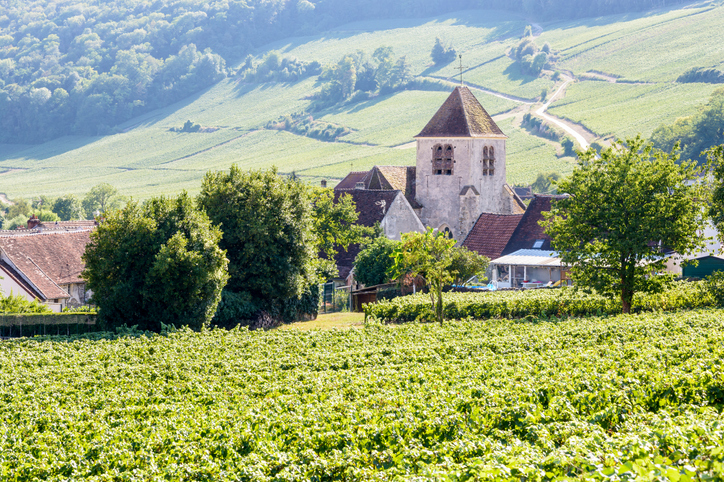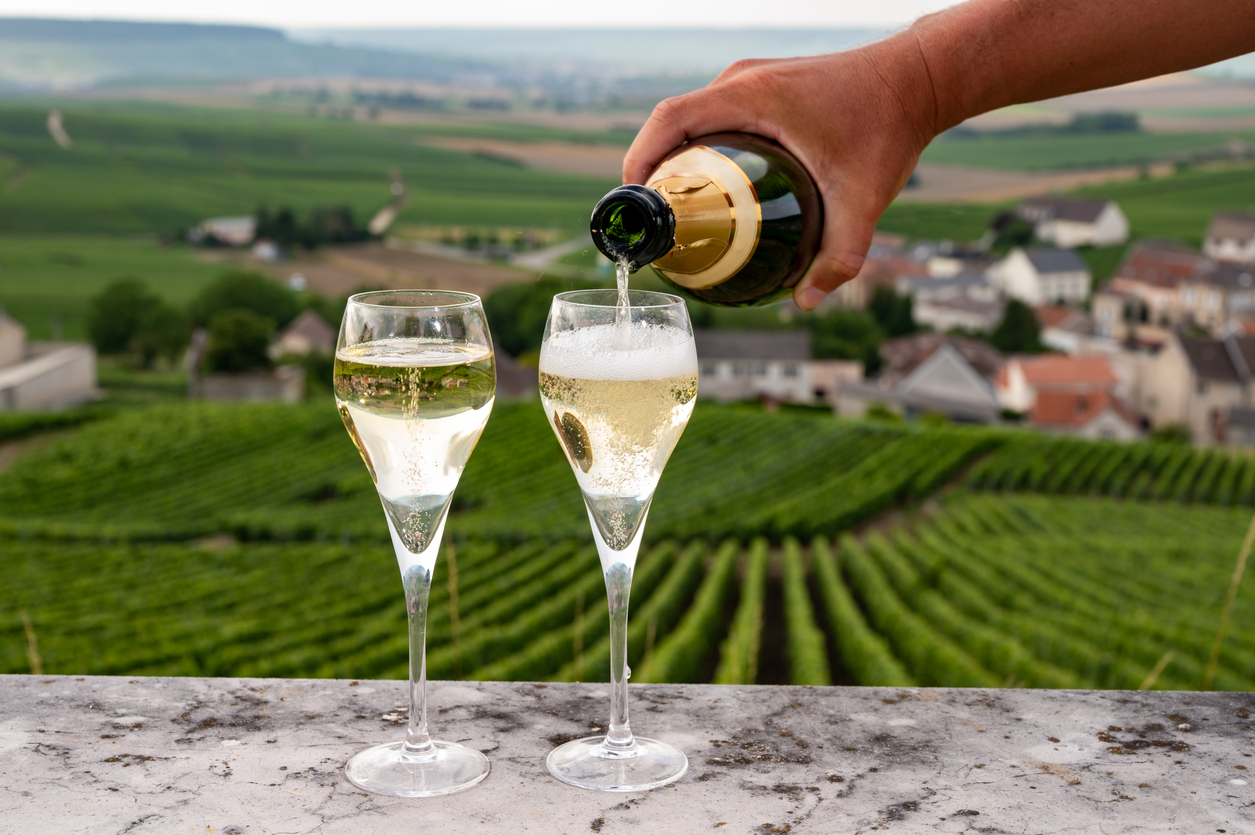Grower Champagne. It’s a buzz worthy term you hear being thrown around New York City’s eclectic dining scene. Chic spots like Air’s Champagne Parlor have extensive grower Champagne lists. But what exactly is it?
What is Grower Champagne?
Grower Champagne is still Champagne. It follows the strict laws and growing practices of the Champagne region. However, instead of being produced by a big Champagne house (think Moët, Veuve, and Pommery) it’s produced by the same estate that owns the vineyards where the grapes are grown. In France, they use the term Récoltant-Manipulant which can be identified by an “RM” on the wine label.
Difference Between Champagne & Grower Champagne
Large champagne houses may use as many as 80 different vineyard plots to source their grapes to maintain an expected stylistic quality with each release.
However, grower Champagne tends to be more rich in the local elements of the terroir that they originate from. Grapes are typically sourced from a single vineyard or vineyard sites located near the house of production. This makes grower Champagne more of a rare product. “Growers” let their terrior take the forefront in the style of the wine as opposed to a uniform house style which is consistent, identifiable, and unchanged year after year.
RELATED: Visiting Champagne France: A Wine Lover’s Travel Guide
Although grower Champagne is not consistent in style year after year, that’s actually the real beauty in it. When you try to make a champagne something it’s not, you lose its innate character and charisma. There’s a seductive quality that Grower Champagne possesses, and its nuances and subtle differences make it all the more enjoyable. After all, who doesn’t like a little spontaneity?
Thomas M. Brems, CEO & Owner of Victorieux Champagne Imports explains that, “Growers do their own bottling and make their own labels, thus making this a true artisan product.” His company is focused on importing wines from producers with a commitment to sustainability. This includes the use of no pesticides, and the individual stories of the growers that are an integral part of their brand. Most of the imports come from the southern Champagne Appellations of Côte de Sezanne, well known for its Chardonnay, and Côte de Bar, well known for its Pinot Noir. One of the Champagne families in his portfolio has been wine making since since 1599 (Arnaud Beaufort & Fils).

Frequently Asked Questions about Grower Champagne
[sc_fs_multi_faq headline-0=”h3″ question-0=”How many Champagne growers are there?” answer-0=”Currently, there are over 19,000 independent Champagne growers. Around twenty-six percent of these growers produce Champagne from their own grapes. Last year, 13% of all exports from Champagne were from wine growers and cooperatives. That is an 8% increase since 2014. This is a statistic that wine importer David Valauri of Coeur de Cuvée can live with. As the sole importer for Delavenne Père & Fils — one of the few Grand Cru grower houses in Bouzy — these Champagnes are extremely nuanced and representative of their commitment to preserving the integrity of their land. Another fantastic aspect of these grower Champagnes is you can even visit producers like Champagne Delavenne simply by making an appointment via email on their website! Just make sure to brush up on your French!” headline-1=”h3″ question-1=”What are some of the best vintages of grower Champagne?” answer-1=”It is important to note that Champagne, including grower Champagne, often consists of non-vintage (NV) blends that combine wines from multiple years to achieve consistency in taste and quality. That being said, certain years have been widely acclaimed for producing exceptional vintage Champagnes, including grower Champagnes.
1990: This year was marked by a warm summer, resulting in rich and concentrated grapes with excellent ripeness. The vintage is known for its aging potential and overall complexity.
1995: The 1995 vintage had a cool, wet start followed by a warm, dry summer. This combination yielded well-balanced wines with good acidity and structure. The Champagnes from this year are known for their elegance and aging potential.
1996: Widely regarded as one of the best vintages in recent decades, 1996 was characterized by a cool, dry summer, which led to high acidity and excellent concentration of flavors. The wines from this year have impressive aging potential and offer both power and finesse.
2002: This year had a nearly perfect growing season, with a balance of sunshine and rainfall that produced healthy, ripe grapes. The Champagnes from 2002 are known for their depth, complexity, and excellent aging potential.
2004: The weather was favorable in 2004, producing a balanced and elegant vintage. The wines from this year have good acidity and are known for their freshness and finesse.
2008: This year was marked by a cool, damp summer followed by a sunny, dry harvest season. The resulting wines are characterized by high acidity and a strong backbone, making them ideal for aging. The 2008 vintage is known for its precision and elegance.
2012: Despite a challenging start to the growing season, 2012 turned out to be an excellent year for Champagne, producing rich and powerful wines with good aging potential. The vintage is known for its balance and intensity.” image-1=”” headline-2=”h3″ question-2=”Why is grower Champagne better?” answer-2=”While it’s not universally true that grower Champagne is better, many wine enthusiasts believe that these smaller, artisanal producers can offer unique and exciting qualities that set them apart from their larger counterparts. Reasons why some consider grower Champagne to be superior include:
Authenticity and terroir
Grower Champagnes are often seen as more authentic expressions of the land they come from. These small producers have intimate knowledge of their vineyards and are deeply connected to their terroir. As a result, their Champagnes can showcase the distinct characteristics of their specific plots, offering a unique sense of place in every sip.
Artisanal craftsmanship
Many growers take exceptional pride in their hands-on approach to winemaking. They manage the entire process, from grape growing to bottling, which allows them to infuse their personal touch and style into their wines. This results in Champagnes with distinctive personalities that reflect the individuality of the producer.
Limited production
Grower Champagnes are typically produced in smaller quantities than those from the larger Champagne houses. This limited production allows the growers to focus on quality over quantity, which can lead to exceptional wines with character and finesse.
A story to tell
There’s something enchanting about knowing the story behind the bottle you’re enjoying. With grower Champagnes, you’re often drinking the fruits of a family’s labor, sometimes through generations of winemaking history. Connecting with these personal stories can enhance your appreciation of the wine and make each sip even more enjoyable.
Value for money
Although not always the case, grower Champagnes can offer excellent value for money. Without the marketing budgets and brand prestige of the larger houses, these smaller producers often price their wines more competitively, allowing you to enjoy exceptional quality at a more accessible price point.” image-2=”” headline-3=”h3″ question-3=”What are some of the best grower Champagne brands to try?” answer-3=”Here are a few grower Champagne brands to seek out. However, these are just a few of the growers available and as the popularity of Grower Champagne increases, more will soon become available for retail across the United States.
- Franck Bonville
- Roger Brun
- Charles Mignon
- Delavenne Père & Fils
- Roger Coulon
- Collard Picard
- Tarlant
- Nowack
- Chartogne-Taillet
- David Léclapart
- Benoît Lahaye
- Roses de Jeanne
- Lelarge Pugeot
- Yannick Prévoteau
- Marie-Courtin
- Vilmart & Cie
- Pierre Péters
- Agrapart & Fils
- Marc Hébrart
- Lequeux-Mercier
- Jean Laurent” headline-4=”h3″ question-4=”What is the price of grower Champagne?” answer-4=”The price of grower Champagne can vary significantly depending on factors such as the producer, the specific cuvée, vintage, and the region or terroir from which the grapes are sourced. However, generally speaking, grower Champagnes tend to offer good value for the quality they deliver. You can find entry-level, non-vintage grower Champagnes for as low as $30 to $50 per bottle, while more premium or vintage offerings can range from $60 to $150 or more per bottle. Some rare and highly sought-after grower Champagnes may fetch even higher prices. Additionally, it’s important to note that prices can vary depending on the country, retailer, or restaurant where you’re purchasing the Champagne.” image-4=”” headline-5=”h3″ question-5=”What are the best glasses for drinking grower Champagne?” answer-5=”The type of glass you choose for drinking grower Champagne can have a significant impact on your overall tasting experience. While there is no specific glass designed solely for grower Champagne, there are two primary styles of glasses that are recommended for enjoying Champagne in general, including grower Champagne.
The Flute
The flute is a tall, slender glass with a long stem and a narrow, tapering top. This shape is designed to preserve the effervescence of the Champagne, showcasing its bubbles and prolonging their release. Flutes are a popular choice for their elegance and the way they visually highlight the sparkling nature of the wine. However, the narrow opening of a flute can limit the expression of the Champagne’s aroma and complexity.
Tulip or White Wine Glass
Many wine experts and sommeliers now prefer tulip-shaped glasses or regular white wine glasses for drinking Champagne, including grower Champagne. These glasses have a wider bowl that tapers slightly at the top, which allows the Champagne’s aromas to develop and express themselves more fully. The shape of the glass can also enhance the texture and mouthfeel of the wine, providing a more immersive tasting experience. Ultimately, the best glass for enjoying grower Champagne will depend on your personal preferences and the specific qualities you wish to emphasize. If you want to highlight the effervescence and enjoy the visual appeal of the bubbles, a flute may be your preferred choice. However, if you are more interested in fully appreciating the wine’s aroma, complexity, and mouthfeel, a tulip-shaped glass or white wine glass may be a better option.” image-5=”” count=”6″ html=”true” css_class=””]
Recommended Wine Glasses for Enjoying Grower Champagne
If you’re in the market for some great Champagne flutes, these lead-free crystal glasses from JoyJolt offer a stylish and unbeatable value currently. Take a look at our recommended wine glasses for white and sparkling wines if you’re considering purchasing a quality set that accentuates more of the aromas and mouthfeel of sparkling wines.
You are reading “What is Grower Champagne? Everything You Need to Know” Back To Top
grower Champagne definition: Champagne itinerary
If you enjoyed this guide, make sure you register to become a Winetraveler for free! You’ll get access to all of our content and receive useful guides and inspiration for travel around the world. Be sure to follow along with us on Instagram as we continue to feature more exciting destinations.
